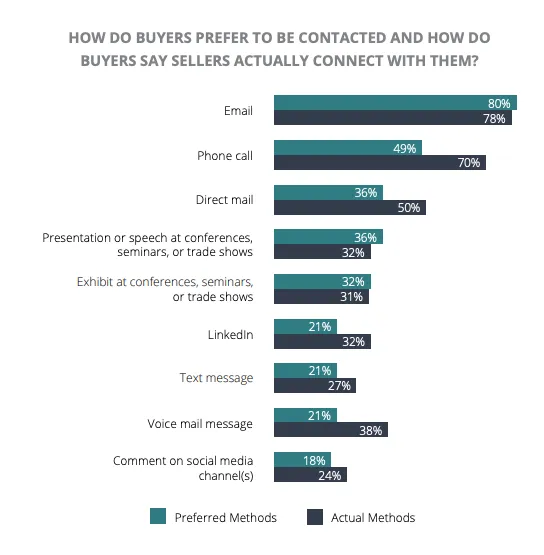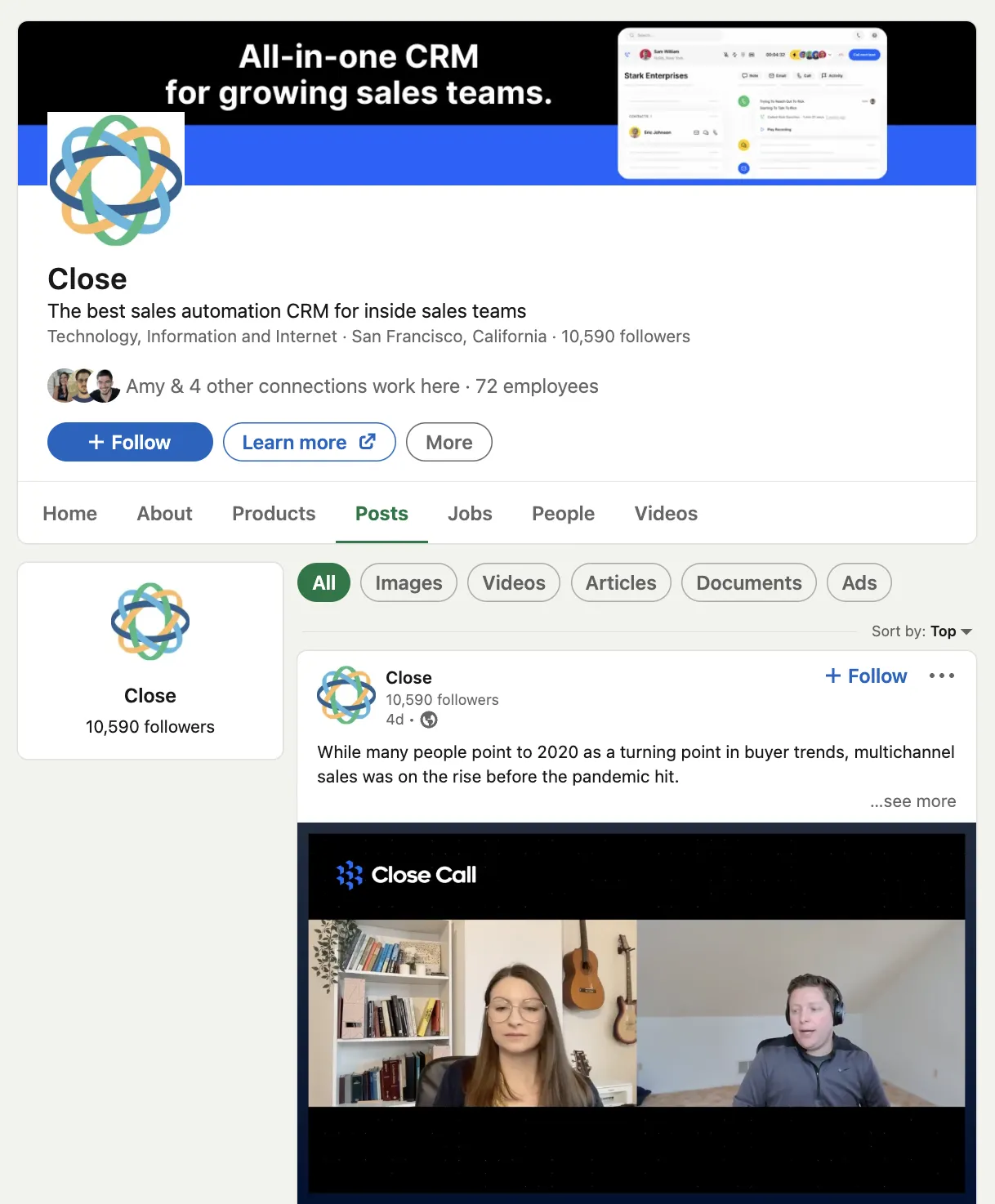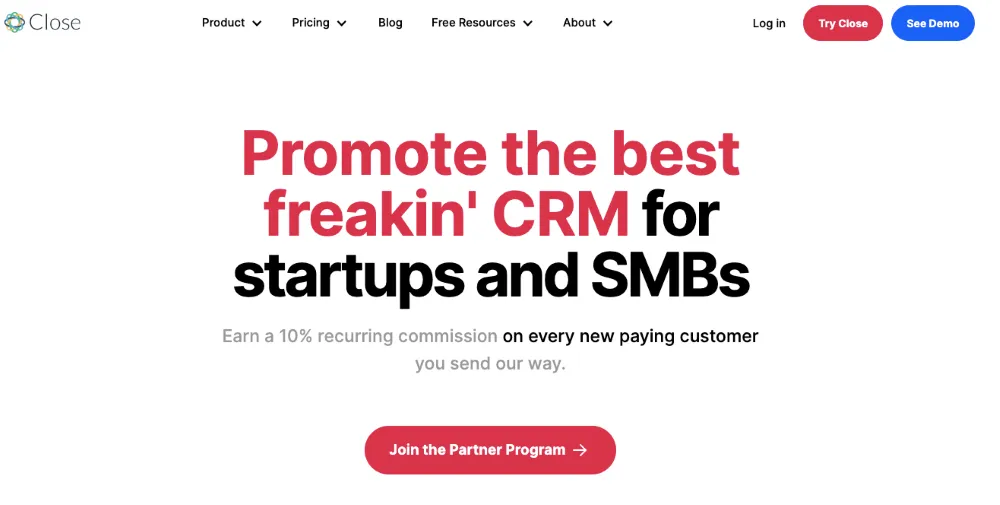
So there you are, trying desperately to hit your sales numbers when someone suggests cold calling.
But wait—people aren’t dialing phone numbers out of the blue anymore, are they? As it turns out, they are. And it’s working, especially when it comes to B2B sales. In fact, 57% of C-level buyers prefer to be contacted over the phone. Enter: the need to build a cold calling list for your sales efforts.
 |
There is one caveat, though: avoid buying your cold calling lists.
It might seem like the easy option, especially if you’re just beginning your cold calling efforts, but who you’re calling matters a lot. You want to focus efforts on prospects who've shown some interest in your product or service, so you aren’t wasting time on people who will never convert.
This guide will share proven, actionable techniques to build a cold calling list (the right way) and tips for creating effective cold calling scripts to help turn leads into happy customers.
But first…
What is a Cold Call?
In either case, the main objective of cold calling is typically lead qualification. Is the prospect interested in your product? Is it a viable sales opportunity? If so, move them to the next stage of the buying process.
You’re not trying to close the deal at this stage. Instead, you’re trying to gauge interest in your offer. And if you schedule a follow-up call or set up a meeting with a decision maker in that process, that’s a major win.
Top-performing salespeople optimize cold calling using a data-driven approach combined with proper sales training, ongoing call coaching, and mock sales calls. They also get their contact information through targeted, purposeful lead generation that provides high-quality prospects. (More on this in a bit!)
And it doesn't matter whether you're in business-to-business (B2B) or business-to-consumer (B2C)—cold calling works in both markets.
(If you're still unsure whether cold calling (or maybe even cold emailing) is right for your business, this article will help you decide.)
The Dangers of Buying Cold Call Lists
Buying a call list from a lead generation company may seem like a great way to save time, but it’s often fraught with problems. Here are the biggest reasons to stay away from buying a list:
1. It’s Usually a Giant Waste of Time
When you buy lead lists, especially cheap ones, you can expect a high percentage of the data to be outdated. We’re talking 30% to 40% in our experience. This means your salespeople might spend of 40% of their time making useless phone calls.
The up-to-date numbers are often a waste of time, too — because about 80% of people in the U.S. ignore calls from unknown numbers.
This results in low conversion rates, with sales reps spending most of their time chasing down prospects with no potential.
So buying lead lists, in most cases, is not the route you want to take. Instead, consider persuading prospects to give you their contact info before calling them (we'll cover how to do this in a bit.)
2. Cold Calling is Expensive (and Has a Very Low ROI)
The cost of buying a cold calling list depends on a variety of factors:
- The number of leads you’re buying
- How targeted the data is (a list of B2B SaaS companies will be more expensive than a general list of businesses)
- What type of data you’re getting (phone numbers, email addresses, annual revenue, contact names, positions, etc.)
- Whether the data has been verified for accuracy
It also depends on your industry. The average cost per lead in retail is $34, whereas in finance you'll pay closer to $160. This means buying 1,000 leads could cost you $34,000–$160,000.
 |
If buying lead lists had a good ROI, the price could be worth it. But it doesn’t. Especially when you consider your lead list will actually cost you twice: first with the money you spend to buy the list, and again with the money you spend contacting all those unqualified leads.
Psst... Looking for the inside scoop on sales headsets? Our article highlights the top 8 choices for cold calling pros like you.
3. Buying a Call List Can Ruin Your Reputation (Think About Telemarketing)
We all know how it feels to be interrupted by a telemarketing rep that’s trying to sell us something we don’t care about. “Hi, Bob in the desert. Want to talk about snow blowers?” Ummm, no.
The problem is that it’s not just Bob who gets annoyed in those situations. All the people (and potential customers) with Bob when you call or Bob’s friends on social media will also be annoyed. The further this annoyance spreads, the worse your company’s reputation becomes.
Besides this, some call lists that aren't well-maintained may include numbers that are on the Do Not Call Registry, and calling them could put you in legal trouble.
How to Build a Cold Calling List for Lead Generation
Now that you know why you shouldn’t buy a cold calling list, let's how to build one instead.
Provide Value to Your Audience (Content Marketing)
The best way to generate leads ethically is by providing real value to your target audience.
Give them a reason to come to you and happily fork over their contact information. Then, your outreach efforts will no longer be cold—you’ll have warm leads that have already signaled their interest in your product.
If you're unsure where to start, the answer is simple: inbound marketing. Often used interchangeably with content marketing, this is a marketing technique where you create helpful, educational, or entertaining content designed to draw customers to your business through SEO (search engine optimization), social media, or other platforms.
Case in point: For us at Close, this has been our top lead generation strategy from day one.
How do we do it? The first step is determining what types of free information or products your audience needs the most. For example, our audience almost always wants to learn about sales. So, we dedicated an entire section of our website to providing the best free books and templates to help them crush their sales goals.
We’ve also published thousands of articles and videos to attract our target market.
The next step is designing a landing page encouraging visitors to stay, learn, and interact. This means having good UX design and frequent opportunities to take action by completing a form, requesting a demo, or otherwise sharing their contact information.
Then, find the appropriate channels to promote your content.
Where does your target market hang out? LinkedIn? TikTok? Google? Post your content on the right channels and attract people to your website. For instance, here’s a snapshot of our LinkedIn page, where we regularly share content that provides value for our audience:
 |
Remember, though, not every new subscriber you get from a free download offer will necessarily be a qualified prospect for your business. It still takes effort from your marketing or sales team to further qualify a lead and determine what’s truly a buying signal.
Need more leads? Our LinkedIn lead generation tactics are a game-changer.
Join Industry Associations
Another way to find new leads is to join relevant industry associations, regardless of your company size. In fact, Maria Ungaro, vice president of the Kellen Company (an association management company), says the top reason people join industry associations is to network and build leads.
"They're meeting new people at industry events, both peers as well as more experienced members to add to their networks," says Ungaro. Since these new people are already engaged in the industry, you will likely meet decision-makers and high-quality contacts.
Plus, joining industry associations helps validate your product or service. It shows potential buyers your business is professionally recognized within the industry.
Finally, it’s a good way to increase your visibility. Many associations have blogs that allow members to write and showcase thought leadership. And you can typically list your business on the association’s directory, publish press releases under member news, and participate on various panels.
Use Affiliate Partners
Affiliate partners promote your product or service using their channels (blog posts, social media, email, and other marketing campaigns) in exchange for a commission on the sale. You’re essentially buying access to someone else’s audience, so it’s an effective way to build a list of prospects and bring in new business for your sales team to qualify.
For example, with the Close Partner Program, affiliates earn a 10% recurring commission on any new customers they refer to us.
 |
Let’s say one of our affiliates recommends us in a blog post and links to our website. A reader clicks through, checks out our product, and fills out a contact form—becoming a new lead. Our team then makes sales calls to nurture the lead through the sales process, and they become a customer! The affiliate then earns a commission.
It’s an effective way to build lists because the affiliate does all of the promotional work, and you get access to new audiences.
When establishing an affiliate marketing program, remember that not all partnerships are created equal. It’s best to look for partners already connected to your product or service, as their recommendations will carry more weight.
For even more ways to build a list of qualified potential customers in your target market, check out our list of the best lead generation ideas to try in your business this year.
How to Create an Effective Cold Calling Script
Once the leads start coming in, it’s time to start making calls. Creating a script is one of the best ways to set your team up for successful cold calling. This section will walk you through five tips to create a cold calling script that converts.
1. Get Your Sales Team (and All Cold Callers) Trained & Ready
Some sales reps may balk at the idea of using a script for their cold calls, saying it turns them into robots. But when you use a script correctly, it does just the opposite. Here are a few reasons why scripts are the way to go:
- They help you train new hires faster and more effectively.
- They put everyone on more equal footing, minimizing the impact when top performers have a bad day.
- They allow your reps to really listen to customers because they’re not stressed about what to say next.
- They’re often based on best practices gained from prior calls and customer research, empowering your SDRs to be more successful.
- They give your top performers a framework to riff off of when they’re feeling creative.
- They keep your messaging focused and concise.
A more creative way to skirt around the need for a full-blown call script these days, is to develop a set of sales talk tracks your team can use for addressing common objections and moving a prospect through the qualification process during a call.
Want to level up your lead conversion strategy? Our article on MQL vs. SQL is a must-read.
2. Get to Know Your Customers
Before you begin working on the script itself, you need to answer an important question: Who are your customers? This allows you to choose your words carefully, focusing on language that’s likely to connect with them.
Before we started Close, for example, we launched an on-demand sales company called ElasticSales. Our ideal customers were Silicon Valley tech startups who’d raised a few million dollars in venture capital. Our goal was to close one deal in four weeks; instead, we landed seven paying customers in 14 days.
Here’s the exact opening script we used:
 |
When we wrote this script, we intentionally chose the term “beta program” because our ideal customer was in tech. This wording was a subtle way to let them know we spoke their language.
3. Collaborate and Draft the Script
Having your team work together on the script is important as each person will have unique insights and suggestions. When writing the script, we suggest following these six steps:
- Clearly state who you are, your company name, and why they should care.
- Give your elevator pitch—a one-sentence overview of what you’re offering and who you’re offering it to (company size and industry are often good qualifiers to add here.)
- Ask a simple question that gives prospects the chance to say no or let you continue.
- Ask questions to learn about prospects' needs and define if they are a good fit.
- Ask questions to discover price sensitivity, decision timelines, and other factors.
- Schedule the next steps with the prospect.
4. Test and Refine
Now it’s time to test out your script with real prospects! When you’re just starting out, you can A/B test different introductions, conclusions, and phrases to gather information on how each prospect reacts.
Use these results to refine your script until it’s truly outstanding. But even after you’ve landed on the perfect script, you should continue to look at reports and create a script variation based on the historical performance data.
If you regularly refine your script, you’ll keep finding new ways to close deals. This doesn’t have to take a lot of time—we recommend setting aside 15 to 30 minutes every month for a focused sales script session with your team.
Best Practices for Successfully Using Your Cold Calling List
Now, let’s dive into a few best practices for building a cold calling list and optimizing your chances of success when making cold calls—whether you’re in SaaS, real estate, finance, insurance, or otherwise.
Build Your Ideal Customer Profile
Normally used by B2B companies, an ideal customer profile (ICP) defines the characteristics of a person or company that’s most likely to buy your product.
This includes demographics, preferred social networks (i.e., LinkedIn, Facebook, Twitter), and pain points. Building an ICP saves your sales team time because they can focus on prospects that are most likely to convert.
Refine and Rehearse Your Sales Call Scripts
You should always be working to perfect your sales script. Adding new information and adjusting to prospects’ reactions can increase conversion rates over time.
And with every change, have reps rehearse the script until they know it by heart; it’s the best way to build confidence.
Schedule Follow Up Calls
Never leave a cold call without a follow-up plan! Schedule another phone call, get a meeting on the calendar, or promise to send useful information to your prospect via email—anything to keep the sale lead alive.
Otherwise, your chances of reaching the prospect again diminish significantly. If you’re a Close user, scheduling follow-ups is as simple as one click in the Close CRM.
 |
This screenshot shows how you can easily assign follow-ups to specific users and schedule dates and times for specific tasks. You can even create automated follow-up sequences using both calls and emails—all within the platform.
Managing all of your communications in one place like this (instead of constantly switching between different apps) allows your team to work way more efficiently.
Focus Your Sales Pitch on Their Pain Points
Here’s an old-school marketing principle: If you can describe your customers’ current problems better than they can, they’ll unconsciously assume you have the solution.
So to keep your prospect engaged and interested, be ready to articulate common paint points and how you can solve them.
Anticipate Objections
Even your best customers will have objections when you're doing outbound sales.
To prepare for this, create an objection management document so you’re ready to face anything prospects might throw at you. Here are some templates to get you started.
Use Quality Sales Prospecting Tools
The right sales prospecting tools & technology can help you close more deals with less effort. Our predictive dialer, for instance, is built into our sales CRM.
The technology detects when a real human answers the phone and then immediately routes the call to an available rep. We like to say it’s the biggest leap in sales productivity since the invention of the phone itself!
Crush Your Cold Calls with Close
You’re now armed with some serious knowledge about cold calls. You know the dangers of buying call lists, how to build your own list, how to create an effective cold calling script, and the best practices to optimize your success rate.
If you’re ready to take it up a notch, try Close—the CRM built for growth and trusted by the world’s fastest-scaling teams.
Close helps you sell more in less time. See Close in action with our ten-minute CRM demo or start your 14-day free trial today!










